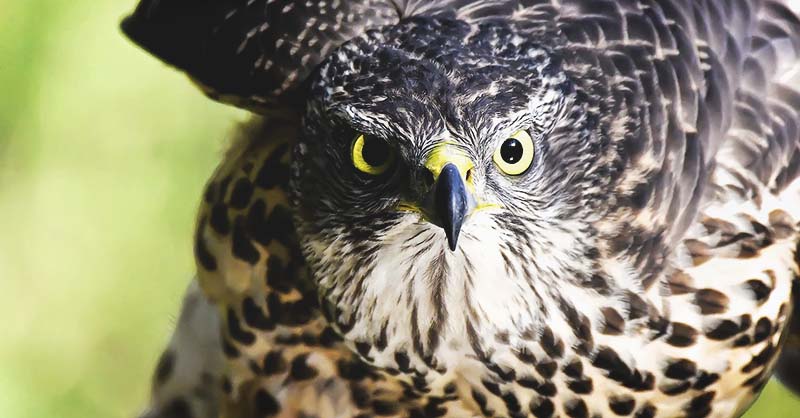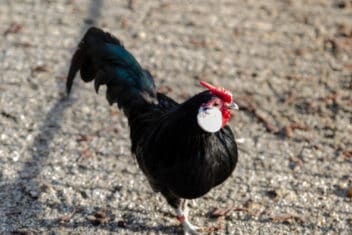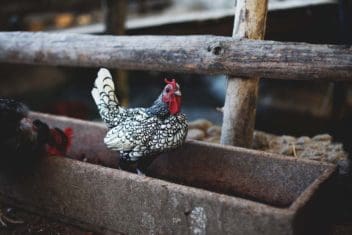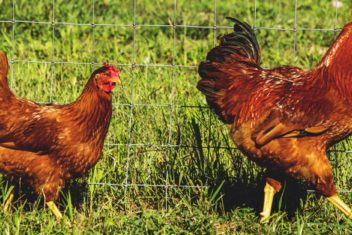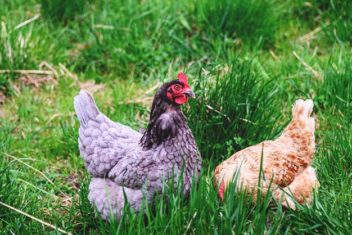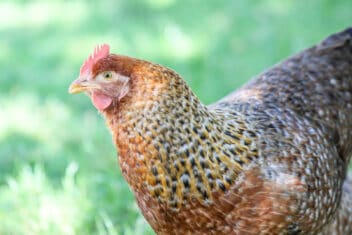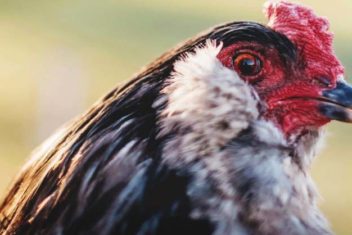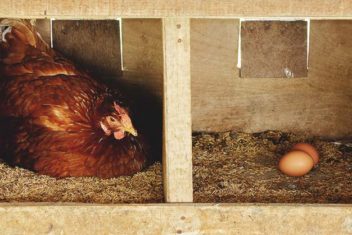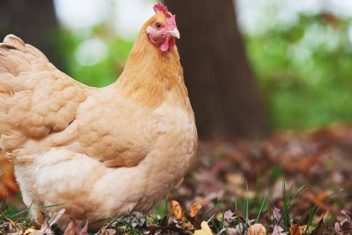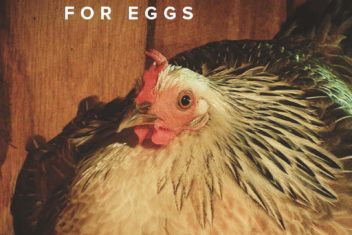My Great Pyrenees puppy erupted into excited barking. My chickens started to sound the alarm in unison. Then, a strangled squawk echoed across our holler.
Without even stopping for shoes, I raced outside just in time to see my best laying hen dive for cover under the stairs leading to our back door. The hawk that was chasing her saw me and high-tailed it out of the area.
I coaxed my chicken out from under the stairs, checked her for injuries, then carried her to her coop. There I gave her some fresh sugar water and a cooked egg to coax her out of her state of shock.
Slowly she came back from that dark, panicked place and began pecking at her treat. I noticed her right eye wouldn’t open. But otherwise, she had no visible injuries. I hoped her eye was just scratched in the scuffle and that she would heal quickly.
The next day, her eye was fine. She started laying like a champ at her usual rate of 4-5 eggs a week despite being 5 years old!
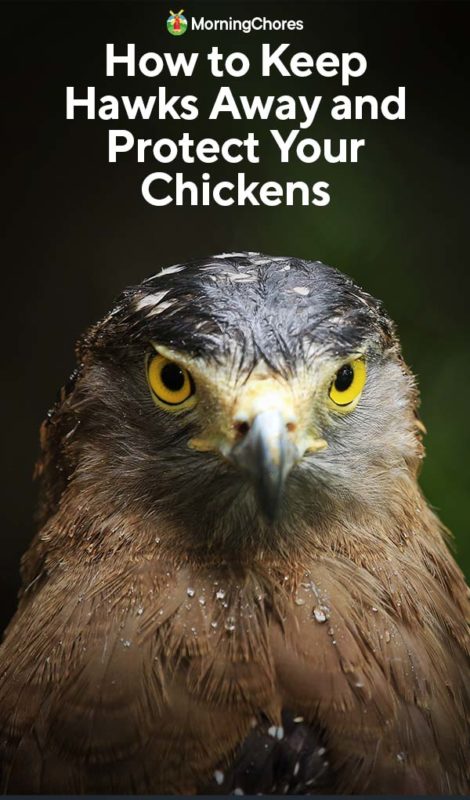
The Sneak Attack
A week later, I walked out to check on the chickens and saw a hawk erupt out of the underbrush in some woods across the way. My stomach sank and before I even saw the grisly scene, I already knew what had happened.
The hawk came back to finish off my best hen. This time though, the hawk had waited until she skirted the woods, and dragged her off into the underbrush. Her neck and face were half-eaten. Her body was still warm, yet she was undeniably dead.
My other chickens hadn’t even noticed that it happened. They were happily clucking around unaware that they’d just lost a flock member. My dog too had remained silent, completely unphased by the fact that she had just failed to protect one of her charges from a predator.
The Relentless Chicken Hawk
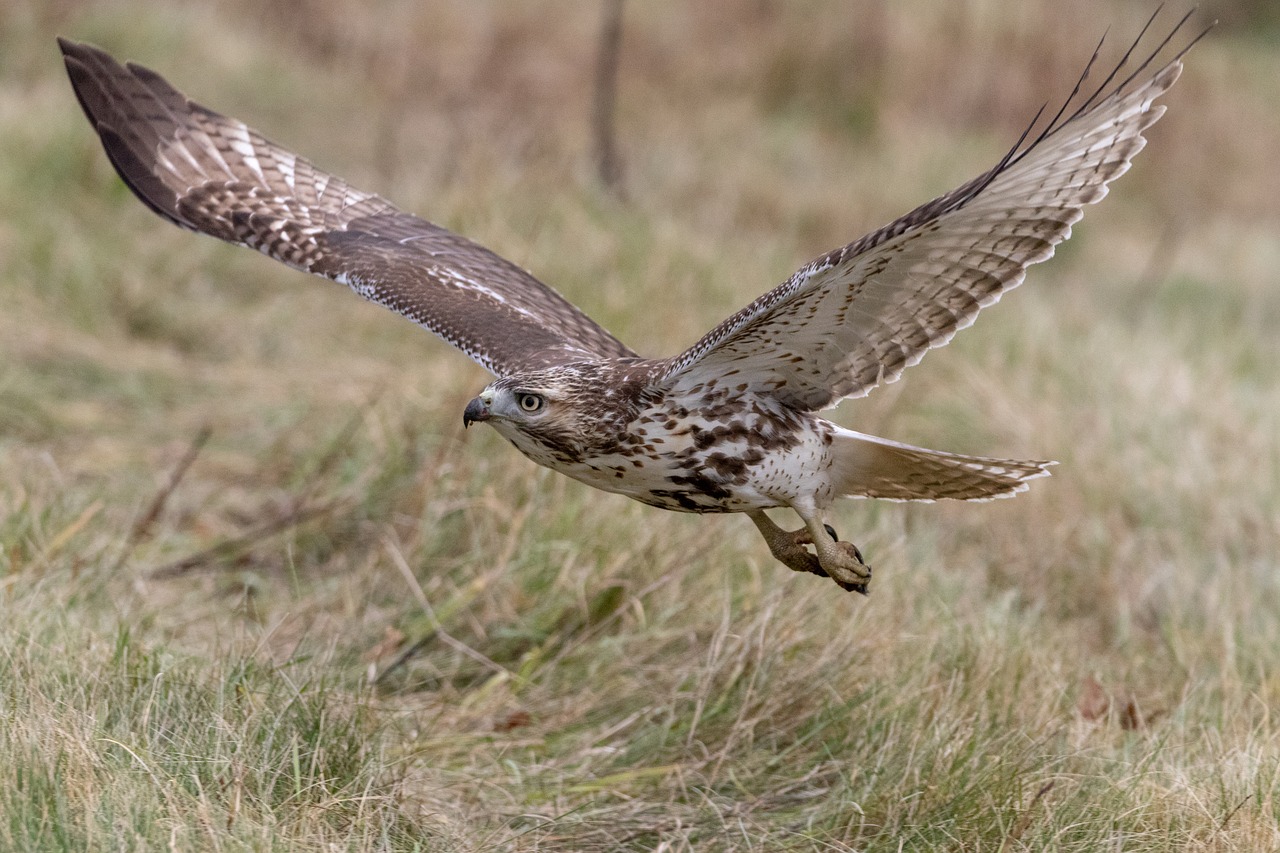
As I picked up poor Rosie’s carcass, I had the sense that someone was watching me. I looked around until I found the source of the sensation.
The hawk perched about 20 feet up on a branch just above watching me and watching my other chickens. I knew then that this hawk had a taste for chicken and wasn’t likely to give up easily.
After that, the hawk came again. And again. In total, I lost four chickens and rescued four more before I finally put an end to the attacks from that relentless chicken-hawk.
Don’t worry! I didn’t hurt the hawk. They are protected by law. Plus they are magnificent birds and this hawk was just doing what hawks does. She was being a cunning bird of prey.
Instead, I changed my chicken keeping methods.
Protecting Your Chickens From Hawks
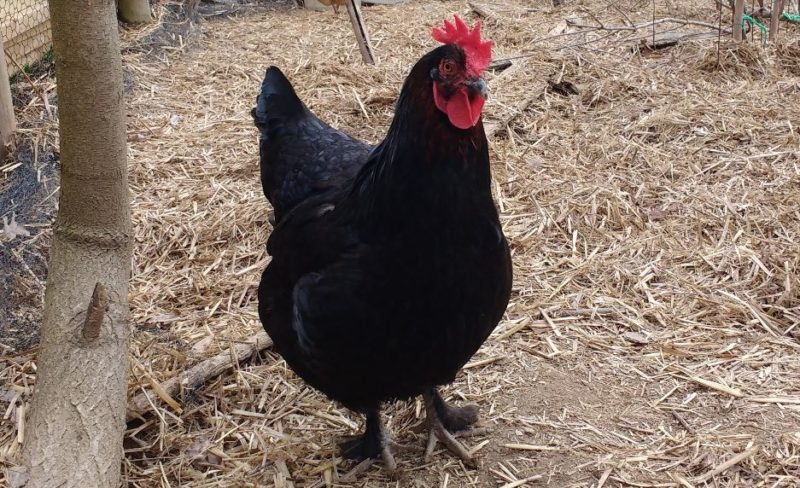
The absolute best way to protect your chickens from hawks is to keep them enclosed in a run that has 360° protection from predators. That being said, there are times when that simply isn’t feasible.
In my case, my run is an irregularly shaped area roughly 55 feet long and 20 feet wide. It’s also got three tall trees and lots of blackberry bushes in it to give my chickens the feeling of being in their native habitat (e.g. jungle). Trying to put a roof over an area like that would be pretty challenging.
I contemplated carving out a portion of that space to create a much smaller run. But my flock was used to free-ranging from sun up to sun down. So even confining the flock to the run was already a hardship on them. Making their run smaller seemed too cruel even to contemplate.
I knew there had to be other answers to solve my hawk problem and still keep my chickens happy.
Understanding Hawk Predation Tactics
SunTzu’s, The Art of War, tells us that to conquer our enemies, we must first understand them.
Okay, so I just made that up. I didn’t actually refer back to an ancient Chinese war-making manual to solve my hawk problem.
I just knew I needed to understand how hawks hunt to be able to mount a formidable defense. So, I hit the internet and learned what I could about hawks. I found out some helpful facts that did ultimately help me solve my problem (at least for now).
Hawk Fact # 1: Hawks Can Hunt Anywhere
On the advice of lots of other long-time chicken keepers, I had believed that long, narrow runs discouraged hawk attacks. The theory was that hawks wouldn’t be as likely to fly into narrow quarters as they would wide open spaces.
Well, in researching hawks, I learned that their long tail feathers act as rudders to help hawks be able to navigate and catch prey even in dense woods. In fact, hawks were actually also designed to hunt in the woods or just about anywhere for that matter.
Hawks will just as happily hunt around ponds or lakes when frogs were in season. They’ll hunt from the
A long narrow run wasn’t going to pose much of an impediment to a relentless, rudder-steering, anywhere-hunting hawk with a taste for my chicken.
Hawk Fact # 2: Hawks Like Easy Targets
Now, some hawks, like the red-tailed hawk that was preying on my chickens, are known for frequently hunting over wide open fields. That’s not necessarily because they have a preference for fields, but because they like easy targets.
Fields usually have lots of mice, voles, and grass-eating rabbits so they make for an easy source of small-sized vermin.
Hawk Fact #3: Hawks Are Prey Too!
Even when hawks hunt in open fields, they prefer to pick up small prey and carry them up to perches to eat them. Either that or they want to drag them into thick brush so they can devour them in private.
Eating out in the open puts hawks at risk for predation by other larger, hawk-eating birds of prey like owls. So, in general, their preference is for small, prolific prey that can be plucked up and carried off.
Hawk Fact #4: Hawks Are Small
Despite those four-foot wingspans making hawks seem like kite-soaring giants, they generally only weigh 4 ounces to 5 pounds depending on breed. Most of the hawks that pose problems to us backyard chicken keepers are in the 1-3 pound range.
Even though they can pick up prey much larger than they are, that’s a lot of work for such a little bird. Plus, hawks are smart. So, they don’t actually want to have to do heavy lifting. It makes them slow and more vulnerable to predation themselves.
Chicks, juvenile chickens, and bantams might be perfect targets for a hawk. But full-sized dual-purpose, heritage breeds, in fact, are not the ideal food source for an intelligent hawk. My hawk was either crazy or having a hard time finding smaller-sized prey.
Hawk Fact # 5: Hawks Hunt From Perches
The image of the hawk soaring down through hundreds of feet of airspace to secure a tiny field mouse is totally true. Well, almost. They can usually spot a mouse from about 100 feet up. However, for practical purposes, most chicken-hawks hunt from perches.
That’s a whole lot easier than taking a 300-foot nose dive on the hopes that a mouse would still be in the same place by the time they covered that distance. That’s also why people often see hawks sitting on power lines or on branches on the outer edges of wooded areas. They are hunting.
Hawk Fact # 6: Hawks Learn Quickly
Young hawks, particularly the Cooper’s Hawk, apparently have a habit of targeting birds eating at garden feeders. Those little birds make an easy target for agile hawks while eating on the sweet treats we leave them.
If the owner of the feeder takes a week off of filling the device, the birds disperse. Then, the hawk will quickly find themselves another easy hunting ground.
This factoid did not specifically apply to my red-tailed hawk. However, in general on the intelligence scale for birds, hawks universally rate high. So, the fact that you could train them to stop coming to an easy hunting ground in a week gave me hope for my chickens.
Out-Maneuvering a Hawk
Armed with my new hawk knowledge, I formulated my plan to discourage the hawk from viewing my chickens as easy prey. Here’s what I did.
Route 1: Change the Routine
For my chickens’ safety, I confined them to their coop and only let them out in the run when I would be working outside in their area. Since it’s garden prep time and I was making some improvements to their coop, they ended up still getting about 7-8 hours outside each day.
I also thought that similar to leaving a bird feeder empty for a week, changing the schedule might encourage my hawk to explore other hunting options.
Route 2: Break Up Space
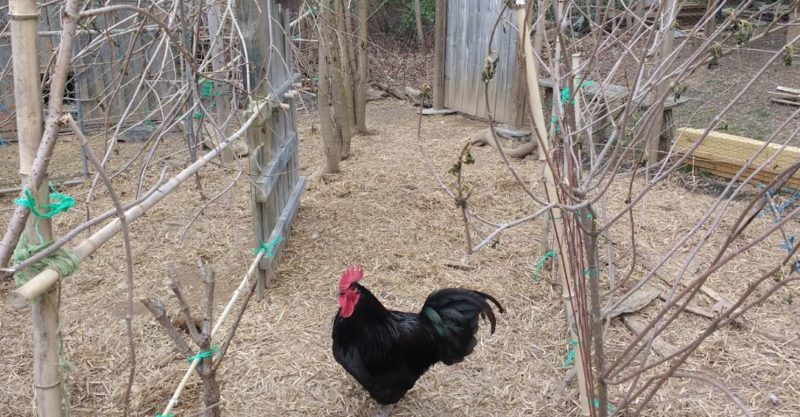
Since hawks like to carry off their prey, I created something like a maze in the chicken yard using bamboo, a broken fence panel, and cuttings from the fruit trees I’ve been pruning.
I needed to be able to get to my chickens in case of emergencies and clean out the run at times. So, I left narrow hallways that I could walk through. But I changed the angles to keep things from being linear.
I attached bamboo bars and pruning scraps to posts at 1, 2, 3, and 5-foot heights, to create a kind of hawk obstacle course. Even if a hawk did manage to get a hen, it would have to go under and over obstacles to carry the chicken to a private spot to eat it.
I thought that by fatiguing the hawk with all those impediments it might give up. Or, at the least, it might slow down enough that my rooster could come to the rescue.
Rooster to the Rescue
In fact, literally right after I put this part of my plan into effect, the hawk did grab a chicken while I had gone into the house to get some water. I arrived back just in time to watch my rooster tear the hawk off my hen’s back and rip out some of its tail feathers.
So, if you have any doubt about the utility of a good rooster, trust me and my uninjured Black Copper Maran, good roosters rock!
Route 3: Stop the Swoop
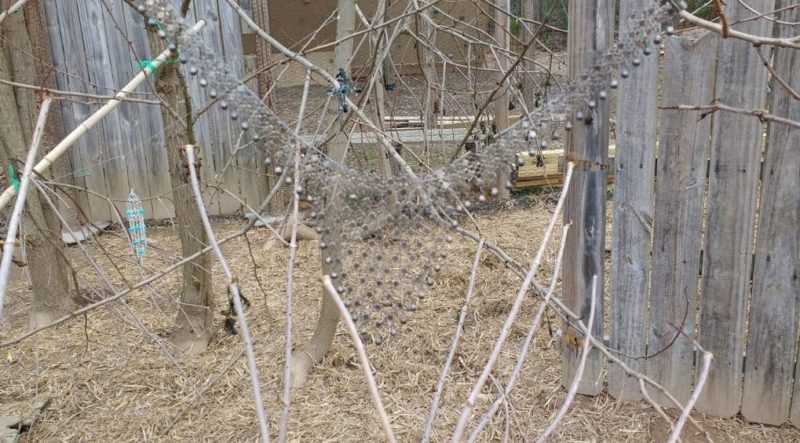
Obviously breaking up space alone wasn’t enough of a deterrent, even if it proved effective against chicken loss. So, I moved on to part 3 of my master plan.
I hung random patterns of crisscrossing fishing line at about 7 feet across all the open areas of the
Hawks have incredible eyesight and can even see in color. So, if a hawk really wanted to swoop down through my safety net, they could. But, knowing how smart they are, I figured if hawks realized it wasn’t an easy in and out, they might think twice about trying it.
Route 4: Remind Hawks They Are Prey
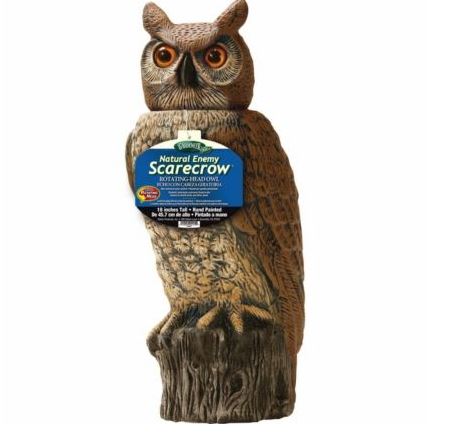
There’s a reason chicken keepers have owl statues around. Along with some of these other measures, they serve to remind hawks that when they swoop for prey, they become prey.
I am not entirely convinced that hawks believe owl statues are a threat. However, when you move those statues around once or twice a week, you can at least make a hawk think twice about putting themselves at risk over prey that are already too heavy to carry.
I also started walking my dog around the run more often. I don’t know for certain this is effective. But the pair of hawks that circle our area always make extra noise when they see her out and about. So, I suspect they are aware of her at least.
Route 5: Save the Dust Bathers
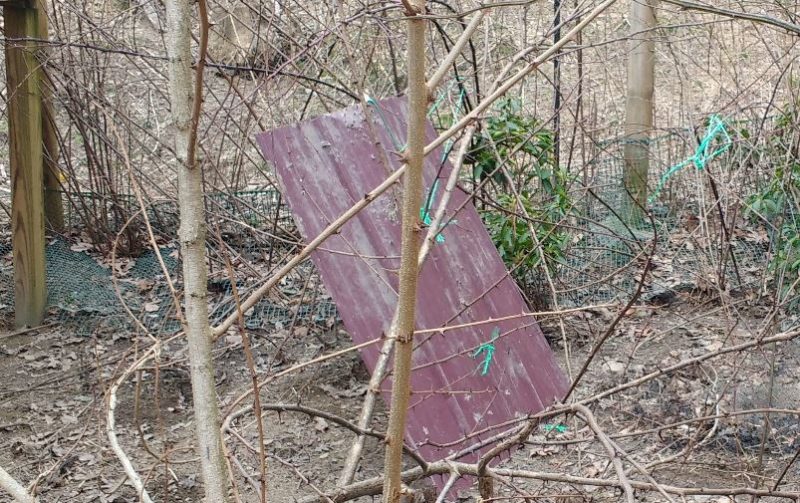
Chickens are most vulnerable when they are relaxed. For example, when they loll about in their dust bath and then spread out and look like a dead chicken, they become perfect targets. Or when they lounge about under leaf-less winter blackberry brambles.
I created a very complicated, actually impenetrable, web of fishing line directly over the area where my chickens dust bathe. Plus, I also set up some paintball-style, hunting blinds using garden stakes and shot-up salvaged sheet metal.
These tools create safer spaces for chickens to relax than under the broad open sky or bare brambles.
Back-Up Plan
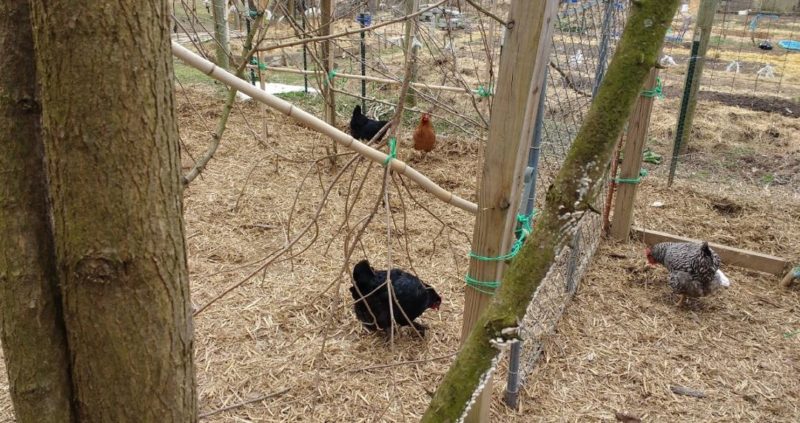
So far, my five-part fix has worked. After weeks of relentless attacks, we’ve gone weeks without any. But, I am a realist.
As part of my research, I also learned that hawks can live for 20 years. They can also spend that whole time in the same location if the weather and hunting
If that happens, I may have to resort to a fully-protected run. Then I’ll have to provide my chickens with lots of chicken toys and fodder to keep confined hens happy. I may also have to choose breeds that are better adapted to confinement than the independent foragers I have relied on for years.
In the meantime though, I’ve made peace with my hawk. I discovered her nest high up in our woods. I understand now why she was so relentless. It’s mating season and she was getting ready to lay her eggs and raise her young.
Hopefully, she tells her chicks that tale of her close call with my rooster and warns them away from that crazy chicken yard obstacle course!

